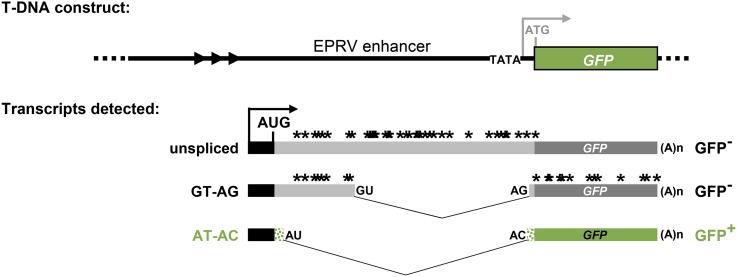Figure 1.
Alternatively-spliced GFP reporter gene used in genetic screen. Top: The T-DNA construct introduced into Arabidopsis comprises a GFP reporter gene under the transcriptional control of a minimal promoter (TATA) and upstream viral (EPRV) enhancer. In the wild-type T line, however, the expected transcription initiation site (gray arrow) is not used. Rather, transcription of GFP pre-mRNA initiates at a cryptic upstream promoter (black bar and arrow). Alternative splicing yields three GFP splice variants: an unspliced transcript, a transcript resulting from splicing of a canonical GT–AG intron, and a transcript arising from splicing a U2-type intron with noncanonical AT–AC splice sites, which are weakly recognized by the U2 spliceosome compared to canonical GT–AG splice sites (Crotti et al. 2007). The unspliced and GT–AG transcripts contain numerous premature termination codons (*). Hence only the AT–AC transcript can be translated into GFP protein. The coding sequence of GFP protein (green bars) uniquely contains a 27 amino acid extension (short stippled green bars) compared to standard GFP (Fu et al. 2015; Kanno et al. 2016). Arrowheads denote a tandem repeat cluster upstream of the cryptic promoter. AUG designates the major translation initiation codon. The 3′ AT splice site is only 3 nt downstream of the 3′ AG splice site (Kanno et al. 2008, 2016, 2017a,b). Figure adapted from figure 1 in Kanno et al. (2018).

